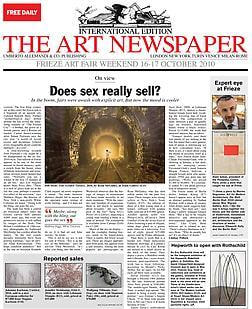
Does Sex Really Sell?
Lindsay Pollock
In the boom, fairs were awash with explicit art. But now the mood is cooler.
LONDON. The first thing visitors see as they enter the Frieze tent is a fragment of an ancient city exposed beneath them. Further “archaeological digs” dotted around the fair reveal the tantalising remains of “The Frozen City”—a brothel, the grave of a female patron, and a Roman art market. Cartier Award-winning artist Simon Fujiwara says the city was “a world of lavish excess and decadence [where] every imaginable desire could be indulged—at a cost”.
A time-travelling resident from Fujiwara’s city might be a bit disappointed by the art fair, 2010-style. This edition of Frieze appears to be one of the most asexual in recent memory: quite a switch from the boom, when titillation, testosterone and temptation-stocked stands helped fuel sales. “Normally you see a wiener in the first 15 minutes at an art fair,” says Los Angeles dealer Marc Foxx (B6). “There is a lack of glitzy-type art at the fair this year, perhaps a cumulative effect of the recession,” says Matthew Higgs, the director of New York’s non-profit White Columns art space. “Along with the bling, out goes the sex.”
The nude has been a central art historical subject since the Greeks carved buff athletes 4,000 years ago, but even our permissive society is still ruffled by images of the flesh. Tate Britain’s exhibition of 19th-century photographs by Eadweard Muybridge has a notice about the nudity. “In the last couple decades museums have been posting warnings,” says art advisor Allan Schwartzman. “This helps condition audiences.” But as the late art historian Kenneth Clark argued, an erotic response is innate. “No nude, however abstract, should fail to arouse in the spectator some vestige of erotic feeling…and if it does not do so, it is bad art and false morals,” he wrote.
This is not to say sex is not for sale at Frieze. “Sex is in the eye of the beholder,” says art advisor Thea Westreich. “It’s what you bring into the room.” Westreich observes that the barrage of images in mainstream life have made sexuality in art more mundane. “With the internet, and freedom of expression, there is not much to annotate about sexuality,” she says. Her pick of the fair? Tariq Alvi’s Poster for a Library, depicting a young man reading a book in a state of arousal. The screenprint is available from Cabinet (D16) for £1,200.
Much of the sex on display—and the examples finding buyers—tends to be toned-down. There is nudity, but fewer sexual acts. There are images appropriated from porn, but applied from a safe distance. Among the most popular are photographs by Ryan McGinley, who has shot nubile nudes for the past five years. These images were strong sellers at New York’s Team Gallery (E15). An edition of three of a thin young man in a tunnel, suffused with golden light, sold out at $35,000 apiece. Another speedy seller was Philip-Lorcia diCorcia’s 2008 Untitled (From the Series East of Eden) featuring a pair of elegant, white dogs glued to a grainy porn video on a television. Five out of eight, priced $25,000 apiece, sold by Friday afternoon.
Then there is work that is a harder sell. Three meticulous ballpoint drawings at London’s Herald St (A5) by Cary Kwok are tucked in a small alcove at the back of the stand. They depict a priest, a Buddhist monk and a Hasidic Jew—eyes closed, aswoon, post-ejaculation. The work has a loyal following, according to Herald’s Nicky Verber, but no sales. At £4,500 each, all three were available.
David Zwirner (G12) has brought a forceful 1964 portrait by the late American painter Alice Neel, priced at $160,000. The middle-aged blonde, Ruth Nude, is seated, legs spread. “We wanted to bring a really strong portrait,” says Zwirner’s Angela Choon. “I’ve been told people love it, but can’t have it at home because of kids.”
Tracey Emin’s embroidered Dark Hole, 2009, at Lehmann Maupin (B13), depicts a disembodied female lower half, recalling the wavering line of Egon Schiele. The composition is stark: between a pair of spindly legs on stilettos, bejeweled hands frame a black orifice. Priced £115,000, the work had attracted interest, but no takers.
Younger dealers said there was plenty of sex lurking at the fair, but noted that a new generation of artists is referencing sex in new, conceptual ways. “If there is sex, it’s more about using the theme of sexuality itself as a topic,” says Zurich dealer Jean-Claude Freymond-Guth, who is showing at Sunday, a fair dedicated to emerging artists. Freymond-Guth’s stand features Megan Francis Sullivan, a straight female artist who appropriates 1950s gay porn into her paintings. (Works are priced $1,400 to $6,000). “It’s extremely coded. It’s not about provocation or subjective desire.”
The Frieze stand of Berlin dealer Johann König (E7) doesn’t appear sexy at first, but an abstract painting by Nathan Hylden, with a smear of creamy white drippy paint, suggests bodily fluids. “Sex does sell,” says Konig’s gallery manager Gregor Hose. “But it has to be visually attractive and abstracted—a well-educated approach to the erotic.” Like Clark, Hose believes art is related to sex. “There’s always libidinous in it,” says Hose. “Why do people buy art? It’s an object of desire.”
